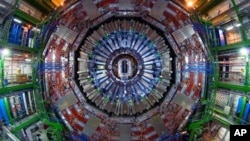Scientists at the CERN physics research center said on Thursday the mystery dark matter that makes up 96 percent of the stuff of the universe will be a prime target for their souped-up Large Hadron Collider (LHC) in the coming years.
They also held out the prospect of other discoveries that could dramatically change the view of how the cosmos works once particle collisions resume in the vast underground complex in two months time.
"I have a dream. I want to see the first light in the Dark Universe," CERN chief Rolf Heuer told a news conference, referring to a concept that includes not just dark matter but the dark energy believed to be driving the universe apart.
"We don't know what dark matter is, but maybe there is a place where we can find it [in the LHC]," said Dave Charlton, spokesman for the ATLAS experiment at CERN, the European Organization for Nuclear Research near Geneva.
The press conference was called before the relaunch of the subterranean LHC later this month, after a two-year shutdown that saw its energy power doubled.
During the first three years of its run from 2010, particles were smashed together billions of times a minute at a collision energy of 7 TeV (tera-electron-volts), each creating a fizzing scenario like that thought to have followed the Big Bang.
It was that apocalyptic event 13.8 billion years ago that led to the creation of the universe, both the known or seeable one and the vastly greater dark version.
The revamped LHC will smash proton particles together at a total energy of 13 TeV, producing up to 10 times more data. These collisions will probably begin late in May, Heuer said.
The first LHC run turned up, by 2012, the signals of the long-sought Higgs boson and its energy field which scientists say plays the key role in converting mass into matter.
The boson was envisaged in the standard model of the make-up of the universe, put together during the 1970s as a draft blueprint of how the whole complex works.
But the model cannot explain many phenomena — including the real nature of gravity, hints of extra dimensions, or the nature and origin of the two dark elements in the cosmic picture.
Latest research by space-based instruments puts the overall content of the universe at 68 per cent dark energy and 27 per cent dark matter with the visible galaxies, stars and planets making up the small remaining portion.
Dark matter is only known to exist because of its effect on the visible material around it.







